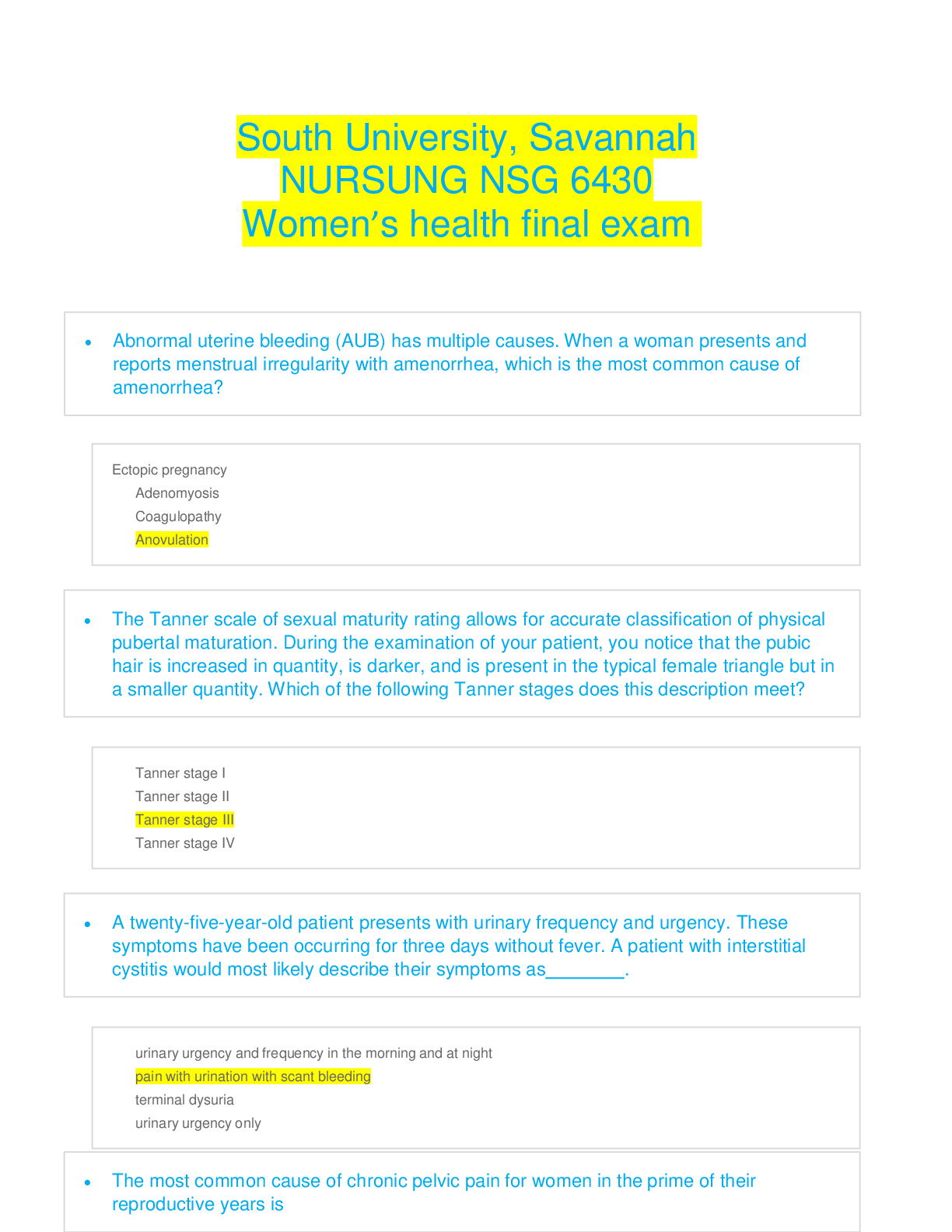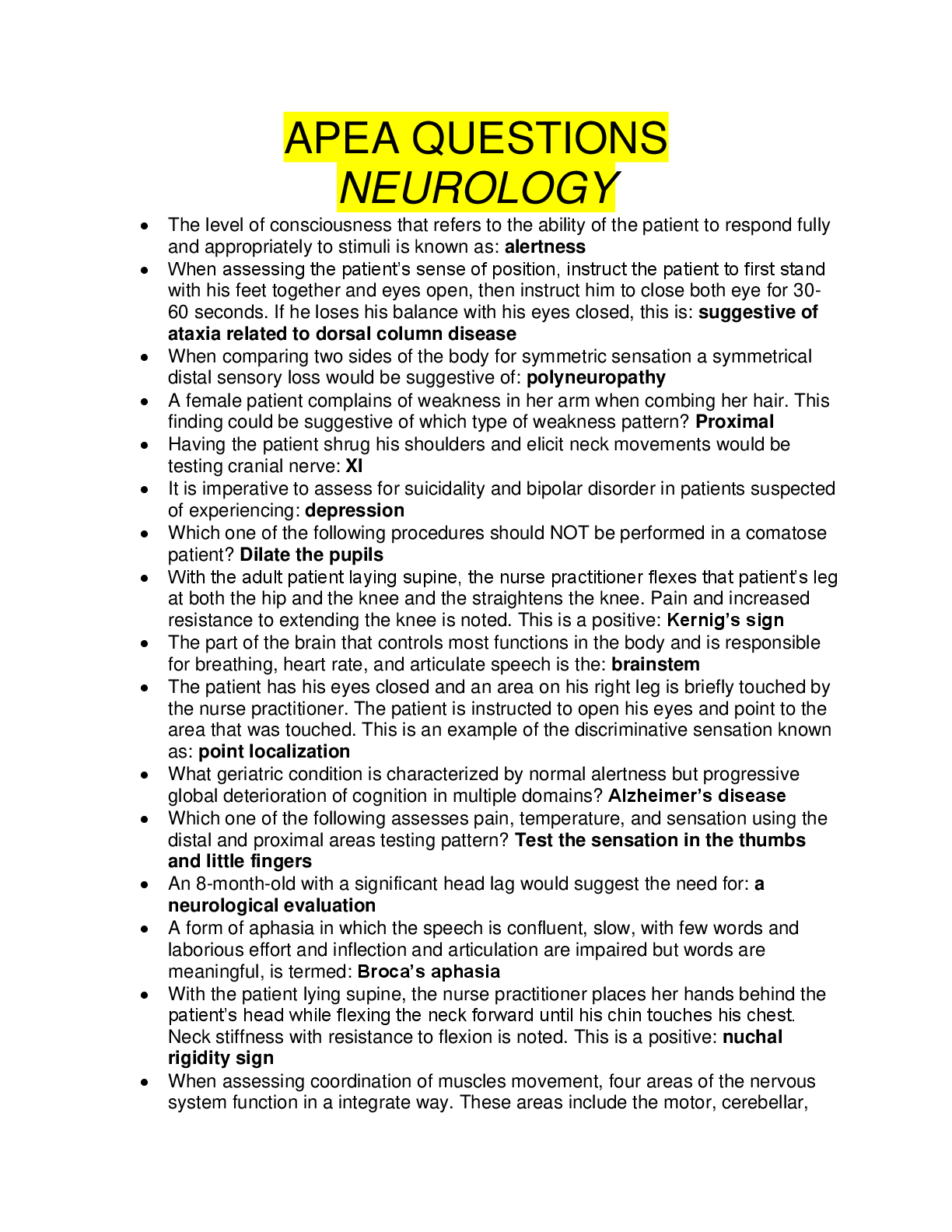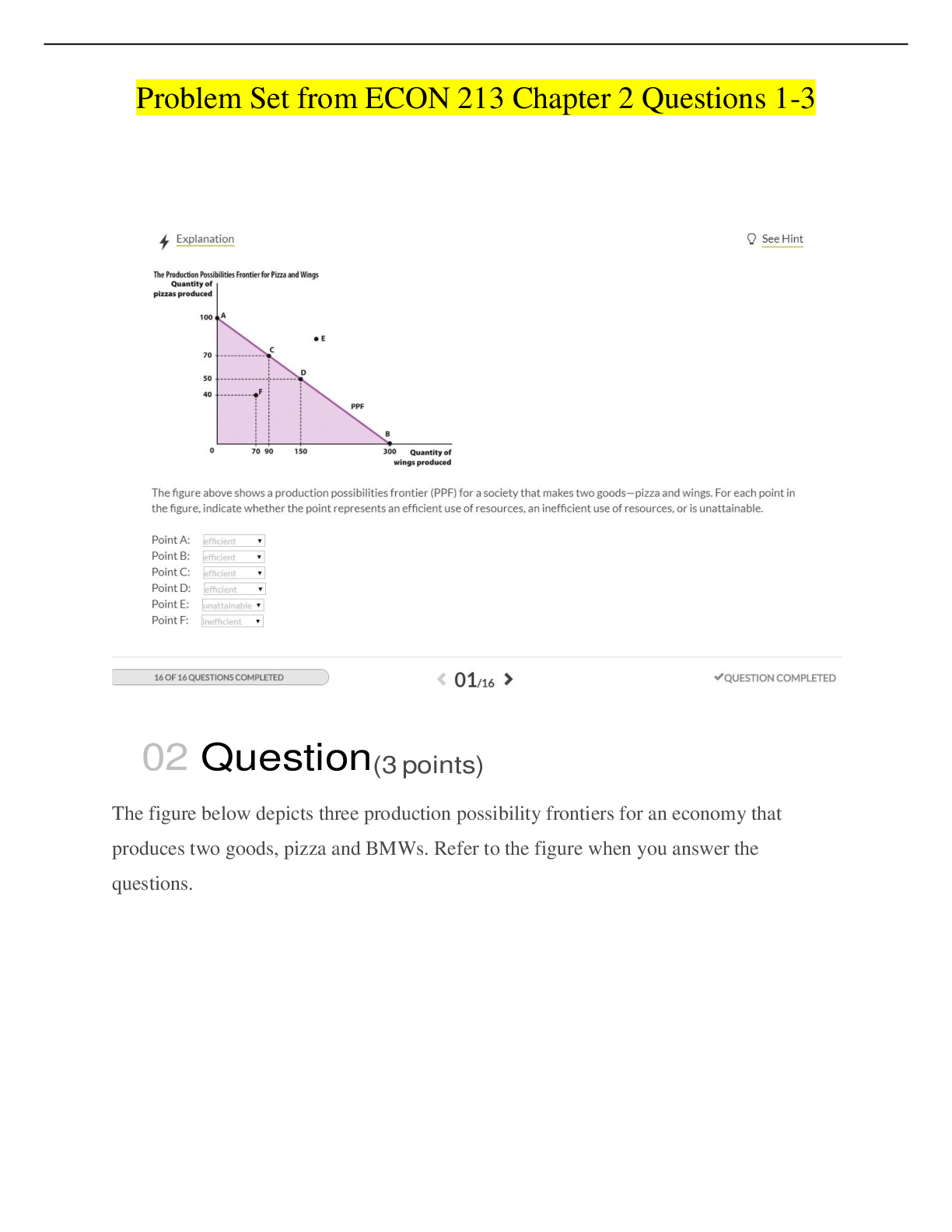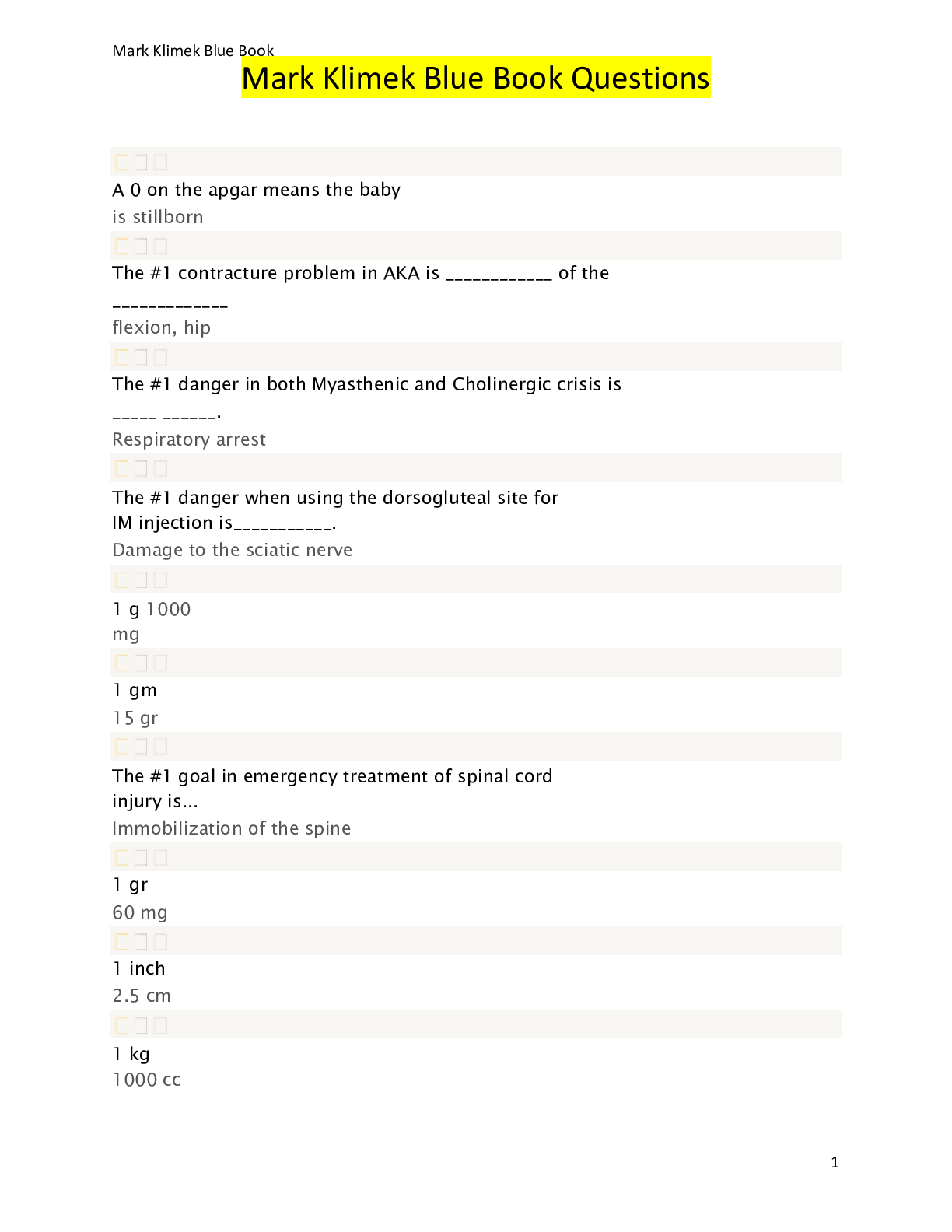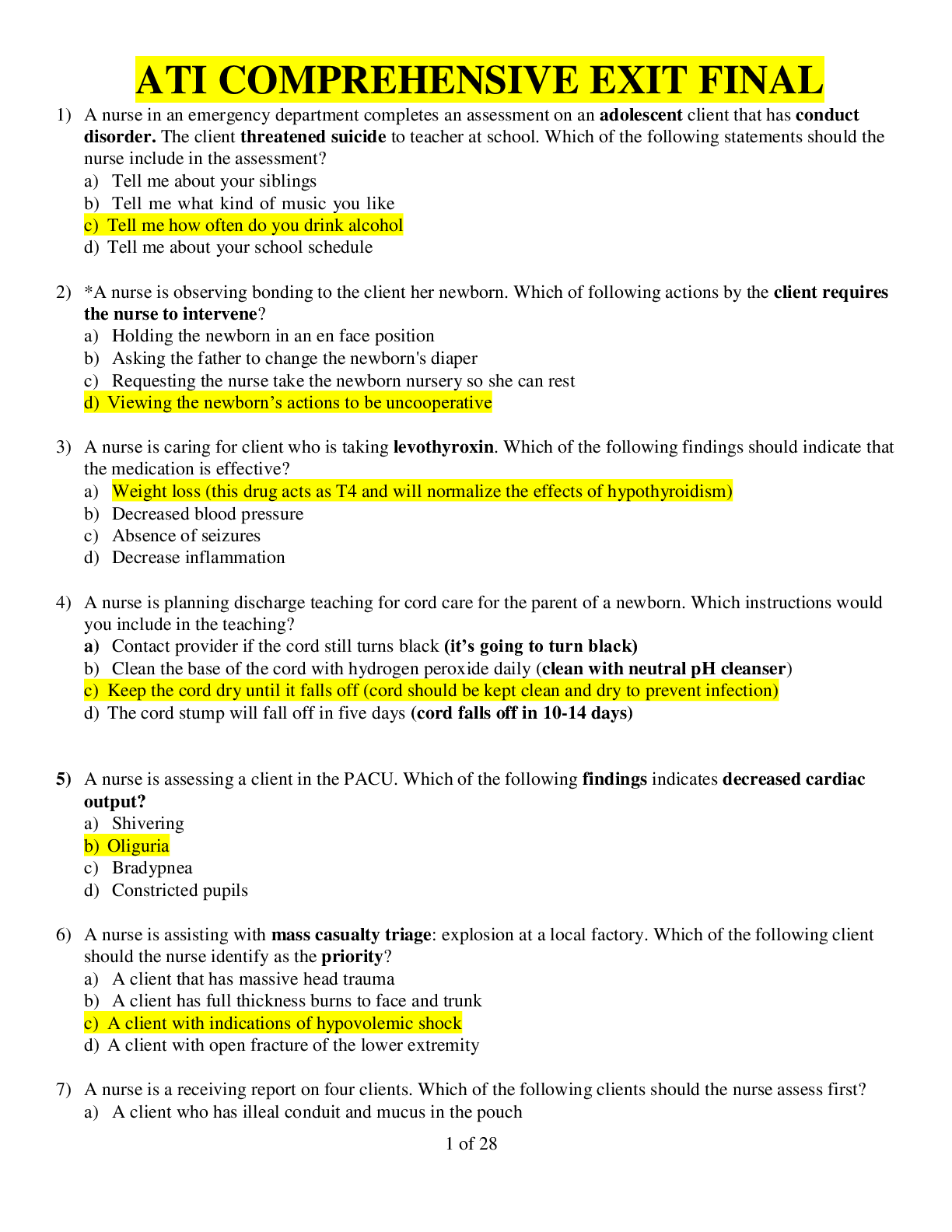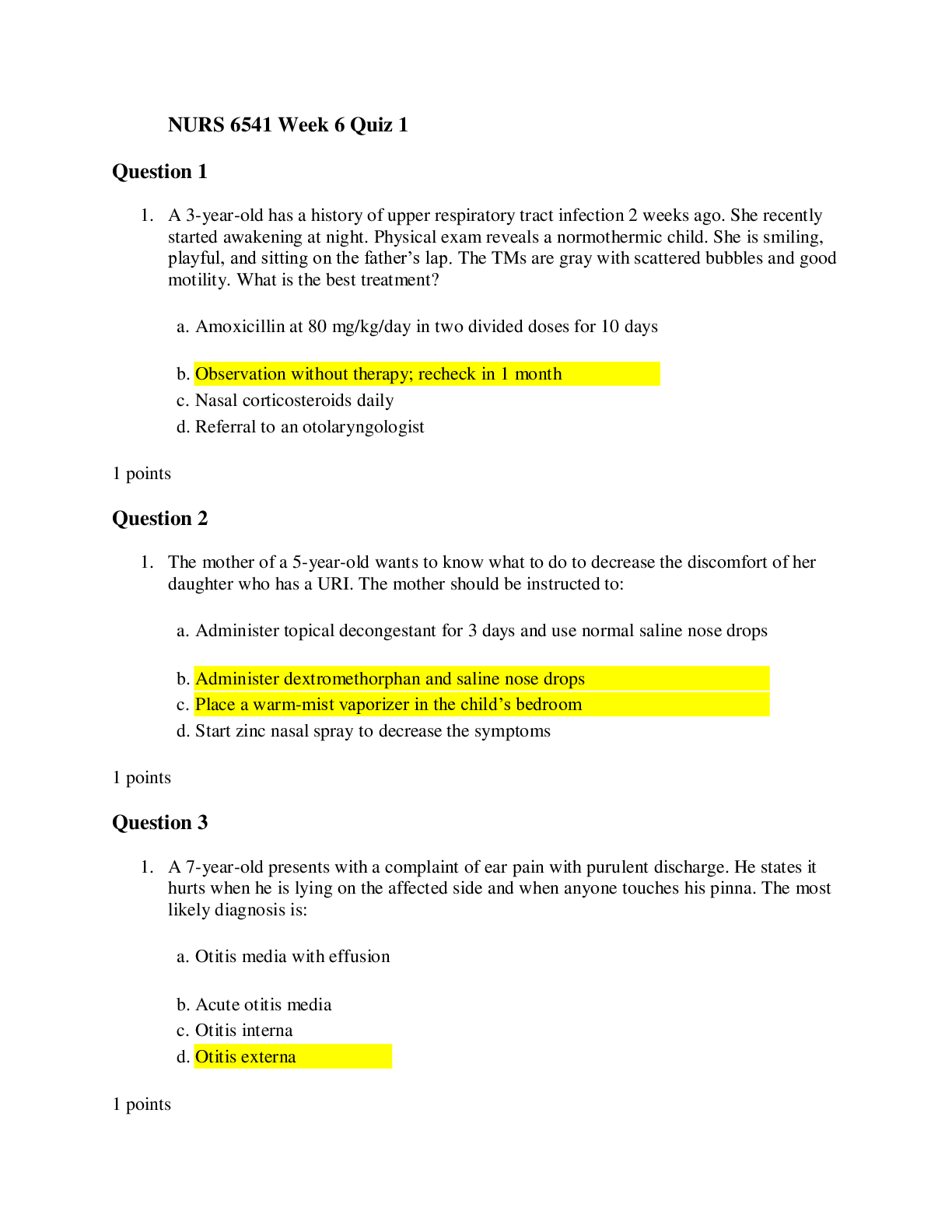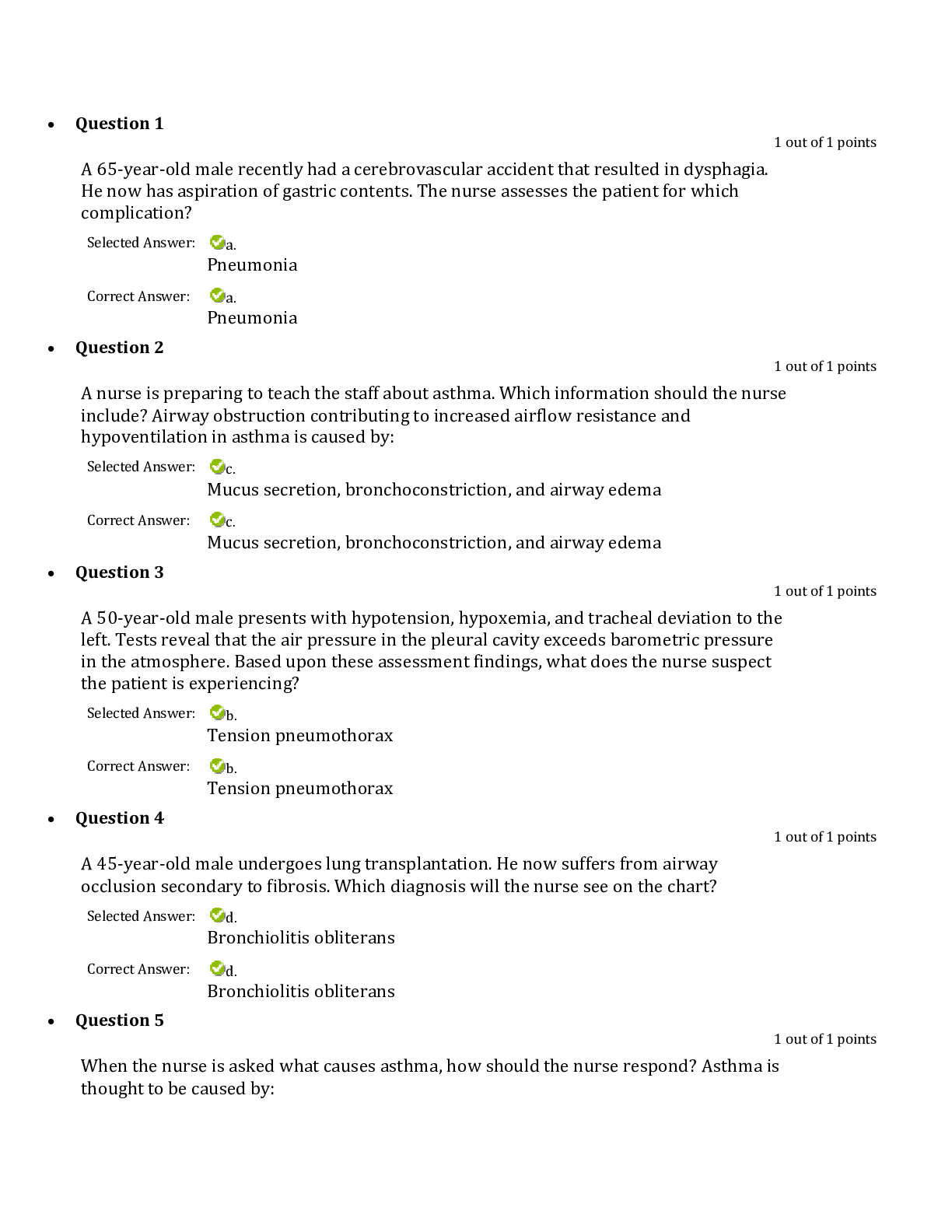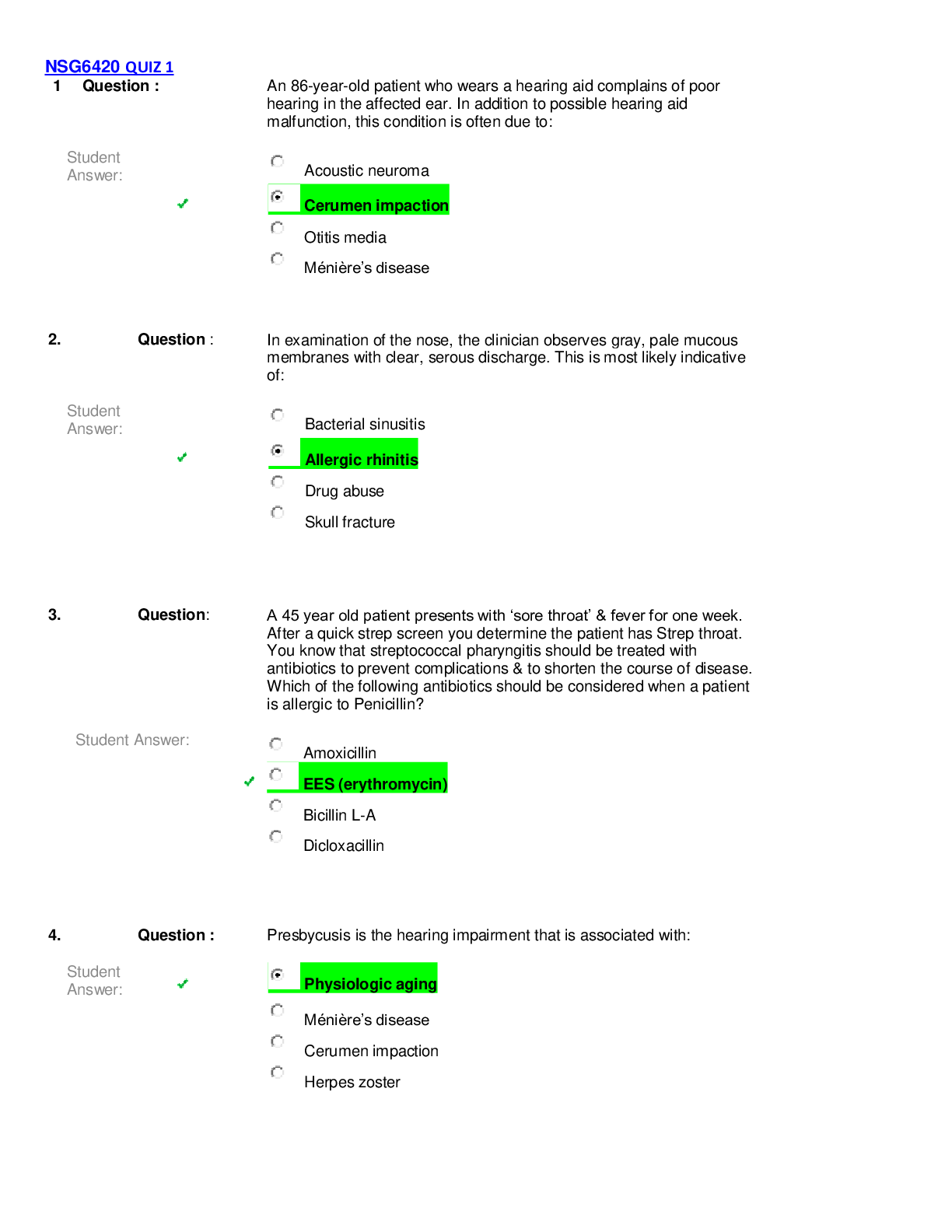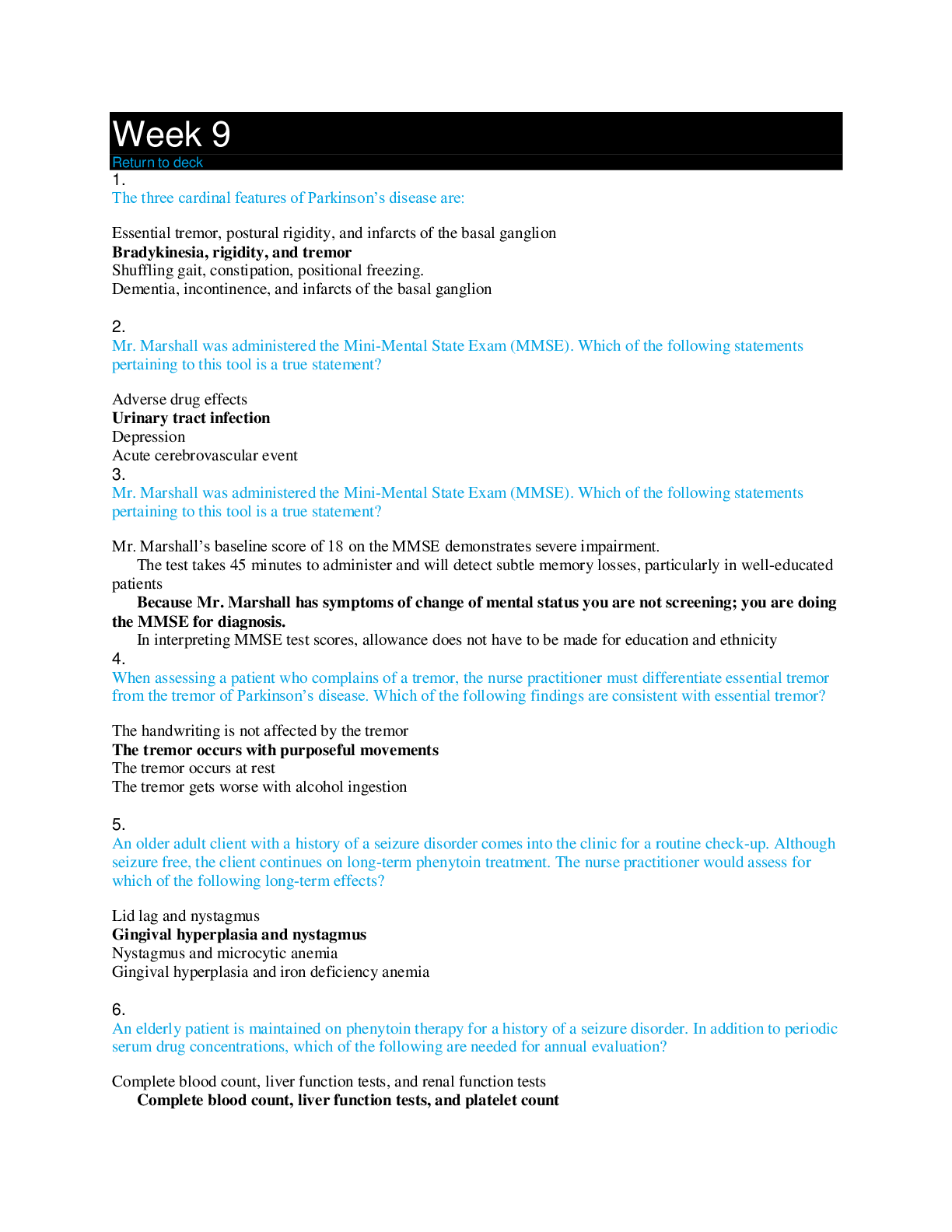*NURSING > QUESTIONS & ANSWERS > South University NSG 6420 Week 6 Quiz / South University NSG6420 Week 6 Quiz (2020, Latest) (Already (All)
South University NSG 6420 Week 6 Quiz / South University NSG6420 Week 6 Quiz (2020, Latest) (Already graded A)
Document Content and Description Below
Week 6 quiz 1. Question :Which ethnic group has the highest incidence of prostate cancer? Asians Hispanics African Americans American Indians Question 2.Men with an initial PSA level below 2.5 ng/m... l can reduce their screening frequency to what intervals? Every 6 months Yearly Every 2 years Every 2 to 4 years Question 3. Your 55-year-old male patient presents to your office with complaints of sudden development of severe right-sided, colicky lower abdominal pain. He cannot sit still on the examining table. The patient has previously been in good health. On physical examination, there are no signs of peritoneal inflammation. A urine sample reveals hematuria and crystalluria. Which is the next diagnostic test that should be done immediately? Ultrasound of the abdomen Abdominal X-ray Digital rectal examination Spiral CT scan Question 4. The most common complication of an untreated urinary obstruction due to a ureteral calculus is: Ureteral rupture Hydronephrosis Kidney mass Renal artery stenosis Question 5. A 43-year-old male patient complains of right-sided abdominal and pain in the back in the right costovertebral angle region, fever, chills, dysuria, and nausea. On physical examination, there is 102 degree fever, tachycardia, and right costovertebral angle tenderness to percussion. The most likely condition is: Lower urinary tract infection Nephrolithiasis Hydronephrosis Pyelonephritis Question 6. On a physical examination for employment, a 45-year-old male shows no significant findings and takes no medications. Past medical history and surgery are unremarkable. On urinalysis, hematuria is present. The urinalysis is repeated on another day and still reveals microscopic hematuria. It is important to recognize that painless hematuria can be diagnostic of: Urinary tract infection Bladder cancer Nephrolithiasis Pyelonephritis Question 7. On DRE, you note that a 45-year-old patient has a firm, smooth, non-tender but asymmetrically shaped prostate. The patient has no symptoms and has a normal urinalysis. The patient’s PSA is within normal limits for the patient’s age. The clinician should: Refer the patient for transrectal ultrasound guided prostate biopsy Obtain an abdominal X-ray of kidneys, ureter, and bladder Recognize this as a normal finding that requires periodic follow up Obtain urine culture and sensitivity for prostatitis Question 8. Age-related changes in the bladder, urethra, and ureters include all of the following in older women except: increasd estrogen production’s influence on the bladder and ureter Decline in bladder outlet function Decline in ureteral resistance pressure Laxity of the pelvic muscle Question 9. Mr. Jones is a 68-year-old retired Air Force pilot that has been diagnosed with prostate cancer in the past week. He has never had a surgical procedure in his life and seeks clarification on the availability of treatments for prostate cancer. He asks the nurse practitioner to tell him the side effects of a radical prostatectomy. Which of the following is not a potential side effect of this procedure? Urinary incontinence Impotence Dribbling urine Selected low back pain Question 10. Your 77-year-old patient complains of frequent urination, hesitation in getting the stream started, and nocturnal frequency of urination that is bothersome. On DRE, there is an enlarged, firm, non-tender, smooth prostate. The clinician should recognize these as symptoms of: Urethritis Benign prostatic hyperplasia Prostatitis Prostate cancer Question 11. Your 24-year-old female patient complains of dysuria as well as frequency and urgency of urination that develops the day after she uses her diaphragm. Urine culture reveals a bacterial count of 100 CFU/mL. These signs and symptoms indicate: Upper urinary tract infection Normal bacteriuria Lower urinary tract infection Urethritis Question 12. A 79-year-old man is being evaluated for frequent urinary dribbling without burning. Physical examination reveals a smooth but slightly enlarged prostate gland. His PSA level is 3.3 ng/ml. The patient undergoes formal urodynamic studies, and findings are as follows: a decreased bladder capacity of 370 ml; a few involuntary detrusor contractions at a low bladder volume of 246 mL; an increased postvoid residual urine volume of 225 ml; and a slightly decreased urinary flow rate. Which of the following is not consistent with a normal age-associated change? PSA level of 3.3 ng/ml Decreased bladder capacity Involuntary detrusor contradictions Increased postvoid residual urine volume Question 13. Mrs. L. Billings is a 77-year-old Caucasian female who has a history of breast cancer. She has been in remission for 6 years. As her primary care provider, you are seeing her for follow-up of her recent complaint of intermittent abdominal pain of a 3-month duration and some general malaise. Given the brief history above, what will you direct your assessment at during physical examination? Examination of her thyroid to rule out thyroid nodules that may contribute to her feeling fatigued. Auscultation of her abdomen for abnormal bowel sounds to rule out peritonitis. Thorough abdominal and gynecological exam to rule out masses and identify any tenderness. A rectal examination to rule out colon cancer as a secondary site for breast cancer. Question 14. A 27-year-old male comes in to the clinic for symptoms of dysuria, urinary frequency, as well as urgency and perineal pain. Transrectal palpation of the prostate reveals a very tender, boggy, swollen prostate. The clinician should recognize these as signs of: Prostatitis Prostate cancer Urethritis Benign prostatic hyperplasia Question 15. Which of the following males would be at greatest risk for testicular cancer? John, a 52-year-old, married African American Attorney who lives in Detroit, MI Jacob, a 22-year-old, homosexual male, who works as an accountant, resides in Cumming GA, and has a history of cryptorchidism Andy, a 27-year-old, Caucasian, single male who resides in Waukesha, WI and works as a maintenance mechanic Ryan, a 34-year-old healthy, married man from Sweden, who works as a Registered Nurse in Boston, MA Question 16. A 43-year-old male patient complains of right-sided abdominal and pain in the back in the right costovertebral angle region, fever, chills, dysuria, and nausea. On physical examination, there is 102 degree fever, tachycardia, and right costovertebral angle tenderness to percussion. The most likely condition is: Lower urinary tract infection Pyelonephritis Nephrolithiasis Hydonephrosis Question 17. Which of the following disorders can cause urinary incontinence? Cystocele Overactive bladder Uterine prolapse All of the above Question 18. Your 18 year old sexually active patient presents with sudden right sided groin pain that is sharp and constant. Inspection of his genitals reveals a swollen and erythematous right scrotum. His right testicle is exquisitely tender, swollen and has no palpable masses. Elevation of the testis results in no reduction in pain. The left scrotum and the testicle are normal. Epididymis and other scrotal contents were within normal limits. The scrotum does not transilluminate. Cremasteric reflex is present on the left side but absent on the right. There is no penile discharge, inguinal lymphadenopathy, or hernias. Based on the history and physical exam your immediate concern is for: Torsion Infection Cancer Rupture Question 19. The Prehn sign is utilized to distinguish epididymitis from testicular torsion. Epididymitis is considered when the Prehn sign is positive. When is the Prehn sign determined to be positive? Pain is relieved by lifting of the testicle. Tender ness is limited to the upper pole of the testis. Lightly stroking or pinching the superior medial aspect of the thigh causes testicular retraction. A small bluish discoloration is visible through the skin in the upper pole. Question 20. Which of the following exam findings makes the diagnosis of testicular tumor more likely? A scrotal mass that is accompanied by exquisite tenderness. Testicular swelling is mostly fluid and transilluminates easily A testicular mass that is non-tender to palpation Dilated and tortuous veins in the pampiniform plexus [Show More]
Last updated: 2 years ago
Preview 1 out of 4 pages
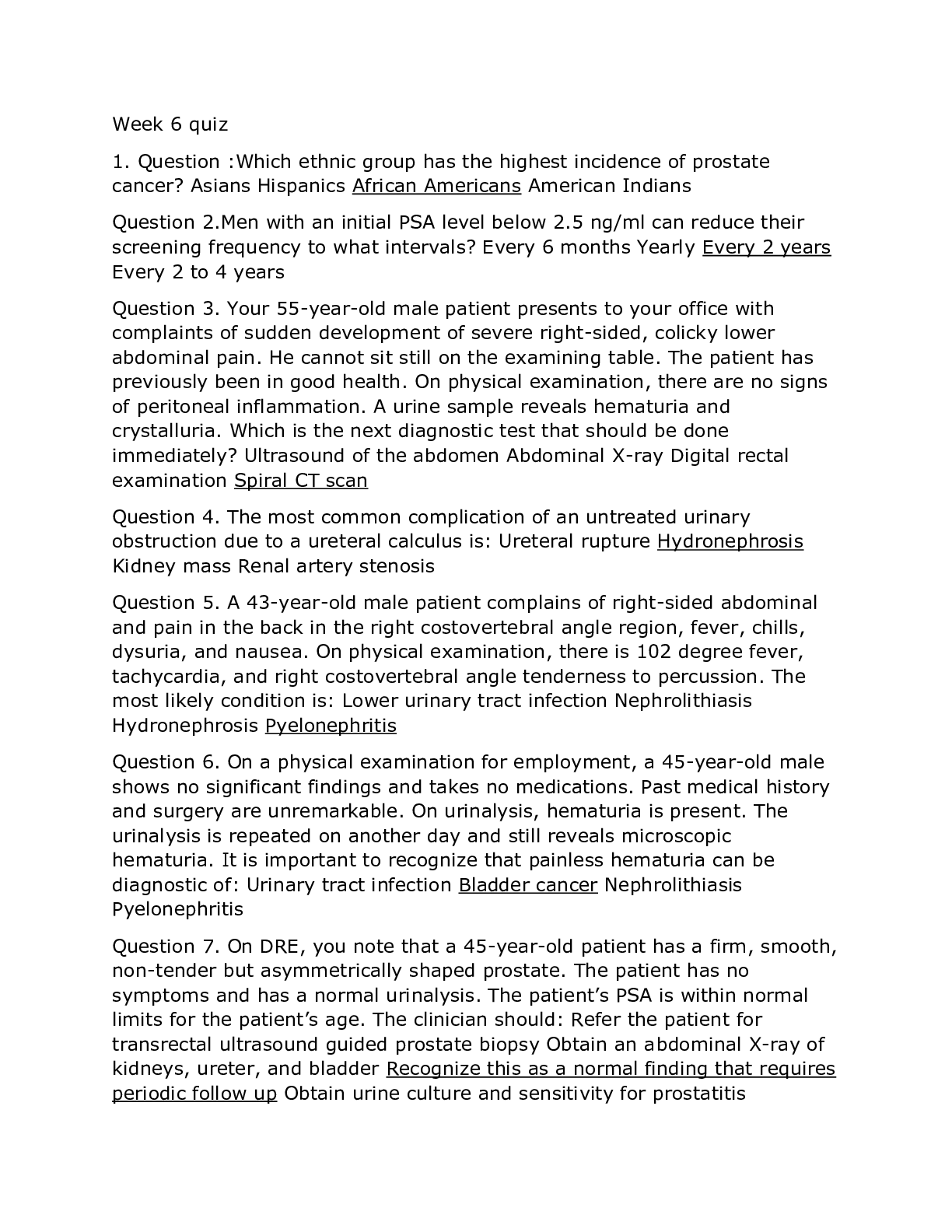
Buy this document to get the full access instantly
Instant Download Access after purchase
Buy NowInstant download
We Accept:

Reviews( 0 )
$5.00
Can't find what you want? Try our AI powered Search
Document information
Connected school, study & course
About the document
Uploaded On
Apr 09, 2020
Number of pages
4
Written in
Additional information
This document has been written for:
Uploaded
Apr 09, 2020
Downloads
0
Views
102

